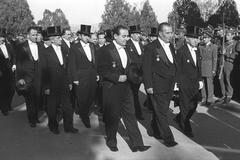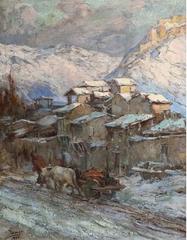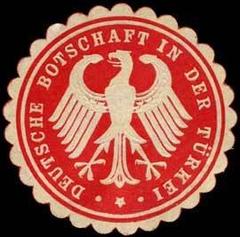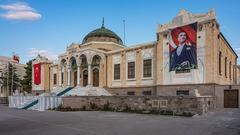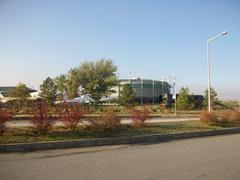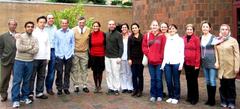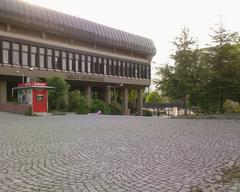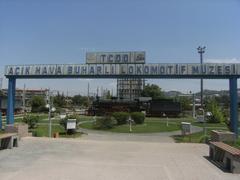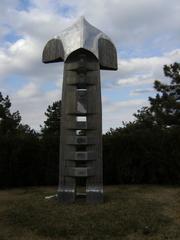
Akköprü Visiting Hours, Tickets, and Historical Site Guide in Ankara
Date: 04/07/2025
Introduction to Akköprü and Its Historical Significance
Akköprü, meaning “White Bridge” in Turkish, stands as one of Ankara’s oldest and most enduring historical monuments. Located in the Yenimahalle district, this Seljuk-era stone bridge was commissioned in 1222 CE by Kızıl Bey during the reign of Sultan I. Alaeddin Keykubad. Serving as a vital crossing over the Ankara (Çubuk) River, it was strategically positioned on the historic Baghdad caravan route, facilitating trade, military movement, and administrative connectivity across the Anatolian Seljuk territories (Yenimahalle Municipality; Türkiye Routes).
Built primarily from local basalt and andesite stones, Akköprü features seven pointed arches—an architectural hallmark of the Seljuk period. The bridge’s robust engineering has enabled it to withstand centuries of floods, earthquakes, and urban transformation, reflecting both the technical prowess and the artistic vision of its creators (Islam Ansiklopedisi). Today, Akköprü remains an open-air monument, easily accessible to visitors and offering a unique link between Ankara’s layered past and its modern urban landscape (Evendo).
This guide provides a comprehensive overview of Akköprü’s history, architecture, visiting information, accessibility, nearby attractions, and essential travel tips, ensuring a meaningful experience for history enthusiasts, cultural travelers, and curious explorers alike (Advantour).
Table of Contents
- Origins and Construction of Akköprü
- Architectural Features and Materials
- Visiting Akköprü: Hours, Tickets, and Accessibility
- Nearby Attractions and Guided Tours
- Photographic Spots and Visitor Tips
- Archaeometric and Geophysical Studies
- Historical Significance and Preservation
- Akköprü in Ankara’s Urban and Cultural Landscape
- Frequently Asked Questions (FAQ)
- Summary Table of Key Features
- References and External Links
Origins and Construction of Akköprü
Commissioned in 1222 CE by Kızıl Bey, Akköprü was built at the confluence of the Çubuk, İncesu, and Hatip Rivers to serve as a critical crossing on the busy Baghdad trade route (Yenimahalle Municipality). The bridge not only enabled the movement of goods and armies but also solidified Ankara’s status as a regional commercial and administrative center during the Seljuk period.
Akköprü’s construction reflects the Seljuk commitment to infrastructure, with its enduring presence testifying to the advanced engineering skills and urban planning of the era.
Architectural Features and Materials
Structure and Design
Akköprü is constructed mainly from cut basalt and andesite stones, locally sourced for their durability. The bridge spans approximately 77 meters in length and 7 meters in width. It features seven pointed arches—four large and three smaller—which allowed for the passage of water and traffic, as well as for the bridge’s resilience to seasonal flooding.
Some parts of the bridge incorporate spolia—reused stones from earlier buildings—adding historical depth and artistic value (Islam Ansiklopedisi). The bridge’s piers are reinforced with upstream triangular cutwaters to minimize water resistance and erosion.
Inscriptions and Ornamentation
Two inscriptions on the western side of the bridge provide historical context. The primary inscription, in Arabic, dates the bridge’s construction to 1222 CE and attributes it to Sultan I. Alaeddin Keykubad. A second inscription has faded over time. While ornamentation is minimal, the careful arrangement of the stonework and the use of spolia reflect Seljuk artistic sensibilities.
Visiting Akköprü: Hours, Tickets, and Accessibility
Hours and Fees
Akköprü is an open public monument and can be visited free of charge at any time. There are no restricted hours, making it suitable for early morning strolls or evening photography (Evendo; Traveloka).
Location and Getting There
The bridge is located in the Varlık neighborhood, Yenimahalle, directly opposite the ANKAmall shopping center and near the Akköprü metro station (Evendo). It is easily accessible by public transport, with various bus and metro lines connecting from the city center.
Accessibility
Akköprü’s surrounding approaches are generally flat and paved, allowing for wheelchair and stroller access. However, the original stone surface of the bridge itself is uneven, so visitors with mobility challenges may need assistance.
Facilities
- Restrooms: Available at nearby shopping centers and cafes.
- Food and Drink: Dining options are plentiful in the surrounding Varlık neighborhood and at ANKAmall.
- Seating: Limited on-site; benches and shaded areas are available nearby.
Nearby Attractions and Guided Tours
While exploring Akköprü, visitors can take advantage of its proximity to several other cultural landmarks:
- Ankara Castle: Offers panoramic city views and a glimpse into Ankara’s medieval heritage (Miss Tourist).
- Museum of Anatolian Civilizations: A world-class museum featuring artifacts from Anatolia’s diverse history.
- Atatürk Cultural Centre: Venue for concerts, exhibitions, and cultural events.
- Roman Temple of Augustus: A short walk away, this ancient site highlights Ankara’s Roman past.
Guided walking and biking tours often include Akköprü as part of a broader historical itinerary. Inquire at local tourist information centers or hotels for options.
Photographic Spots and Visitor Tips
Akköprü’s arches, robust piers, and scenic riverside setting make it a favorite spot for photographers. The best times for photography are early morning or late afternoon, when the light accentuates the pale stonework.
Visitor Tips:
- Visit during weekdays to avoid crowds.
- Wear comfortable shoes for the uneven stone surface.
- Combine your visit with shopping or dining at ANKAmall for convenience.
- Bring a camera or smartphone for close-up shots of inscriptions and decorative details.
Archaeometric and Geophysical Studies
In 2009, Akköprü was the subject of a detailed archaeometric and geophysical investigation (Academia.edu). Ground-penetrating radar revealed that parts of the southern arches have become partially buried due to urban development. The research confirmed the use of both local and repurposed materials, highlighting the bridge’s layered construction history and the importance of continued preservation.
Historical Significance and Preservation
Akköprü is not only an architectural feat but also a symbol of Ankara’s enduring legacy. It was depicted on the reverse side of the 5-lira banknote between 1927 and 1937, underscoring its national importance (Yenimahalle Municipality). The bridge has undergone several restorations, most notably in the 1960s and again in 2022, ensuring its structural stability and historical authenticity (Rayhaber). Vehicular traffic is now prohibited to protect the monument.
Akköprü in Ankara’s Urban and Cultural Landscape
Today, Akköprü stands at a crossroads between ancient and modern Ankara. Its proximity to contemporary attractions like ANKAmall and the metro station reflects its ongoing relevance as a gateway to the city. The bridge remains a focal point for community events, local festivals, and cultural gatherings, symbolizing Ankara’s historical continuity and resilience (Adventure Backpack).
Frequently Asked Questions (FAQ)
Q: What are the visiting hours for Akköprü?
A: Akköprü is accessible 24/7 as an open-air monument.
Q: Is there an entrance fee or ticket required?
A: No, visiting Akköprü is free of charge.
Q: Is Akköprü wheelchair accessible?
A: The approach to the bridge is paved and generally accessible, but the bridge’s stone surface is uneven; some visitors may require assistance.
Q: How do I get to Akköprü by public transport?
A: Akköprü is easily reached via the Akköprü metro station or city buses to the Varlık neighborhood.
Q: Are there restrooms or food vendors at Akköprü?
A: Restrooms and dining options are available at nearby shopping centers and cafes.
Q: Can I take photographs or fly drones at Akköprü?
A: Photography is encouraged. Drone use may require special permission in urban areas.
Summary Table of Key Features
| Feature | Description |
|---|---|
| Construction Date | 1222 CE (619 AH) |
| Patron | Sultan I. Alaeddin Keykubad / Kızıl Bey |
| Materials | Cut basalt and andesite stones, spolia |
| Length | ~77 meters |
| Width | ~7 meters |
| Number of Arches | 7 pointed arches |
| Largest Arch Span | Central arch: 10 meters |
| Parapets | Originally stone; now with modern railings |
| Inscriptions | Arabic inscription (1222 CE), second inscription (faded) |
| Restoration | Multiple; major works in 1960s and 2022 |
| Heritage Status | Protected urban site since 1959 |
Practical Information and Travel Tips
- Best Time to Visit: Spring and autumn offer the most comfortable weather.
- What to Bring: Comfortable shoes, camera, water, and sun protection.
- Accessibility: Suitable for families and groups; caution advised on uneven surfaces.
- Safety: The area is well-lit at night and considered safe, but standard precautions are recommended (My Adventures Across the World).
- Public Transport: Ankara’s Ankarakart (rechargeable transit card) can be used for easy travel around the city (Türkiye Today).
- Cultural Etiquette: Respect the site as a protected monument; avoid damaging the structure or leaving litter.
References and External Links
- Yenimahalle Municipality: Akköprü
- Türkiye Routes: Akköprü
- Islam Ansiklopedisi: Akköprü
- Advantour: Ankara
- Evendo: Akköprü
- Academia.edu: Archaeometric Studies
- Rayhaber: Restoration Completed
- Wikipedia: Akköprü
- Miss Tourist: Things to Do in Ankara
- Adventure Backpack: Ankara Culture
- Traveloka: Akköprü
- Tourist Places Guide: Ankara
- My Adventures Across the World: Turkey Travel Tips
- Türkiye Today: Navigating Ankara
Final Call to Action
Akköprü is a timeless bridge between Ankara’s Seljuk past and its vibrant present. Whether you seek architectural marvels, historical insight, or picturesque strolls, Akköprü offers a memorable experience. For the latest updates, personalized itineraries, and exclusive travel content, download the Audiala app and follow us on social media. Let Akköprü be your gateway to discovering the best of Ankara’s historical and cultural heritage!



